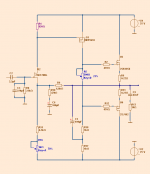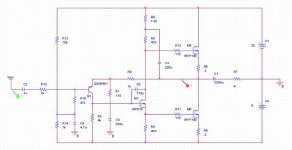But on the other hand i prefer caps to servos...they are the least of the evils...I clearly prefer the tinfoil/film caps...
I'm planning to avoid caps & servos but I would be interested to hear about the sonic signature of a servo that you do not like.
mike
Regardless of how you implement it.. you make the active device of the servo part of the circuit...I cant say how the imprint will be on this circuit, but on preamp's they are clearly audible..they take away texture and adding solid state haze...(not really sure that that is the right word, but the one that springs to mind)
The Most SIMPLE Fetzilla
swordfishy
talked about a bootstrapped version
with only 4 active devices, transistors.
This version is the most simple I can think of.
Thanks to bootstrap distortion is a bit higher
THD=0.030% at 1kHz 1Watt
One current source is replaced by bootstrap.
The other current souce is replaced by potentiometer.
Transistors:
- input 2SK170BL
- vas IRF9610
- output 2SK1058 2SJ162
This will work.
It may evenso sound good.
But this I do not know. Yet.
Enjoy
swordfishy
talked about a bootstrapped version
with only 4 active devices, transistors.
This version is the most simple I can think of.
Thanks to bootstrap distortion is a bit higher
THD=0.030% at 1kHz 1Watt
One current source is replaced by bootstrap.
The other current souce is replaced by potentiometer.
Transistors:
- input 2SK170BL
- vas IRF9610
- output 2SK1058 2SJ162
This will work.
It may evenso sound good.
But this I do not know. Yet.
Enjoy
Attachments
Swordfishy,
I was thinking, For me some of the best in depth work JLH published were his articles describing his designs in electronics magazines.
The first and classic one was "simple class A amplifier"
and a real masterpiece was "80-100 Watt MOSFET Audio Amplifier" Part 1, 2 & 3
not sure if it's easy to get hold of these but if you are interested, when my things arrive from the USA I could send you copies.
I was thinking, For me some of the best in depth work JLH published were his articles describing his designs in electronics magazines.
The first and classic one was "simple class A amplifier"
and a real masterpiece was "80-100 Watt MOSFET Audio Amplifier" Part 1, 2 & 3
not sure if it's easy to get hold of these but if you are interested, when my things arrive from the USA I could send you copies.
This version is the most simple I can think of.
Thanks to bootstrap distortion is a bit higher
THD=0.030% at 1kHz 1Watt
I think for such a design a really good power supply design will be even more important than normal.
I would bias it into class A and use a L C L C PSU
( L = inductor, C = capacitor )
. . . but it might be simpler just to add the CCS's
Now we're cooking with gas.... I love the ol' bootstrap, it's a fail safe building block and it introduces H2 and H3, no bad thing. It can be tweaked slightly by using dissimilar resistor values.
Servos are fine if well designed, MiiB. And caps are pretty good if they have a DC polarising voltage across them! We all have our preferences, however, and I defend to the death your right to hold them.....
Amplifiers should practise safe sex, particularly with fragile jfet gates at the input. There should be a blocking cap. And if there is a blocking cap, it should have some volts across it.
As for power supply, since this design takes both its first stage current return and its feedback at source , it will have quite high PSRR. You will find it's very, very quiet, probably rather better than -100dB S/N ratio.
BTW, JLH did a Class A mosfet design many, many years ago. You might cast an eye over it; it's very, very similar to this design although it is quasi complementary (but notice the compensation, lots of it!).
Cheers,
Hugh
Servos are fine if well designed, MiiB. And caps are pretty good if they have a DC polarising voltage across them! We all have our preferences, however, and I defend to the death your right to hold them.....
Amplifiers should practise safe sex, particularly with fragile jfet gates at the input. There should be a blocking cap. And if there is a blocking cap, it should have some volts across it.
As for power supply, since this design takes both its first stage current return and its feedback at source , it will have quite high PSRR. You will find it's very, very quiet, probably rather better than -100dB S/N ratio.
BTW, JLH did a Class A mosfet design many, many years ago. You might cast an eye over it; it's very, very similar to this design although it is quasi complementary (but notice the compensation, lots of it!).
Cheers,
Hugh
Attachments
Last edited:
As for power supply, since this design takes both its first stage current return and its feedback at source , it will have quite high PSRR. You will find it's very, very quiet, probably rather better than -100dB S/N ratio.
There we are Hugh, we doing have some things in common. We both like cooking with gas and we both appear to be liberally minded . . . . But if you don't like being called a liberal I respect your right to be called something else
One question, were your comments describing swordfishy's diagram or Lineup's ?
I'm guessing you were describing swordfishy's whereas my comments were referring to lineups diagram ( 584 )
For me, it seems like a big advantage to have the feedback point not connected to the neg rail ( only if it is connected to the neg rail then it would be better to use a CCS - and a very good one at that ! )
Is that what you meant by "since this design takes both its first stage current return and its feedback at source" I hope so otherwise I'm confused
I think we might be agreeing again - but I'm not sure
Mikelm,
I would love a copy of those articles!
I had the pleasure of nipping home at lunch time today to listen to the bootstrap version. Its sound is as good as the CCS version in my opinion. The only possible slight difference was maybe a little less bass, but if this is the case it is very slight.
However, I now understand and believe that the bass ability of this amplifier is largely dependent on OLG. Adding the bootstrap slightly decreases the OLG as it is not a perfect current source. I think a smaller VAS degeneration resistor will increase OLG and restore the bass. I will try this tonight. I might shoot for 20R or something. Hopefully stability will not suffer.
If this works OK the bootstrap version officially becomes my favourite circuit.
I would love a copy of those articles!
I had the pleasure of nipping home at lunch time today to listen to the bootstrap version. Its sound is as good as the CCS version in my opinion. The only possible slight difference was maybe a little less bass, but if this is the case it is very slight.
However, I now understand and believe that the bass ability of this amplifier is largely dependent on OLG. Adding the bootstrap slightly decreases the OLG as it is not a perfect current source. I think a smaller VAS degeneration resistor will increase OLG and restore the bass. I will try this tonight. I might shoot for 20R or something. Hopefully stability will not suffer.
If this works OK the bootstrap version officially becomes my favourite circuit.
Perhaps it would be good to try a bigger bootstrap Cap before Changing the OLG ?
I was just thinking the same thing. I remember when I made my JLH class A, the size of the bootstrap cap had a big influence. Will try that tonight.
220uF rolls off your OLG from about 70hz
1000uF or 2200uF should help with your bass but you have a lot less OLG in the bass region with the bootstrap. Reducing the degeneration resistor to 20 will give you about 6dB extra gain in the bass region but this is still about 22dB less than you have with CCS @ 100hz and more than 30db less @ 20hz.
1000uF or 2200uF should help with your bass but you have a lot less OLG in the bass region with the bootstrap. Reducing the degeneration resistor to 20 will give you about 6dB extra gain in the bass region but this is still about 22dB less than you have with CCS @ 100hz and more than 30db less @ 20hz.
We both like cooking with gas and we both appear to be liberally minded . . . . But if you don't like being called a liberal I respect your right to be called something else
Ah, Mike, you can call me anything you like, regardless, though I must warn you I'm still me....
One question, were your comments describing swordfishy's diagram or Lineup's ?
I'm guessing you were describing swordfishy's whereas my comments were referring to lineups diagram ( 584 )
Yes, SWF's circuit. I actually don't like the 1st stage CCS Lineup is using, I prefer Linsley Hood's original, elegant circuit where the entire output from the jfet is routed through the feedback resistor. Simpler, and improves PSRR.
For me, it seems like a big advantage to have the feedback point not connected to the neg rail ( only if it is connected to the neg rail then it would be better to use a CCS - and a very good one at that ! )
Is that what you meant by "since this design takes both its first stage current return and its feedback at source" I hope so otherwise I'm confused. I think we might be agreeing again - but I'm not sure
Yes, precisely. I should have said,
'I like the fact that the entire first stage current is passed to the output rail via the feedback resistor, NOT to the rail, where injection of half wave rectified artefacts of the lower output device would be inevitable.'
You have to be careful describing Australians as liberal - our conservative party here is called the Liberal Party, and is equivalent to your Tory Party. 'Owzat, huh?
Hugh
- Status
- This old topic is closed. If you want to reopen this topic, contact a moderator using the "Report Post" button.
- Home
- Amplifiers
- Solid State
- JFET input, MOSFET VAS, LATERAL output = Perfect!!

